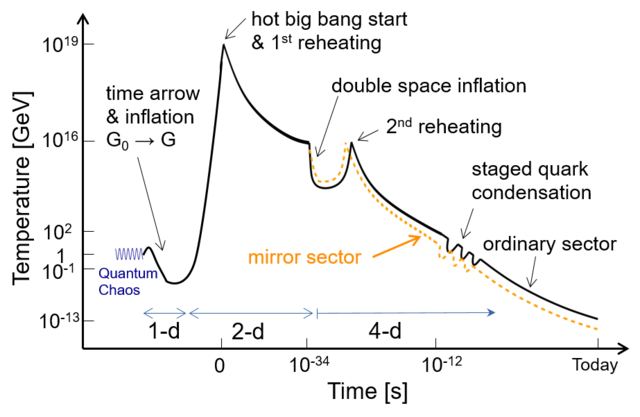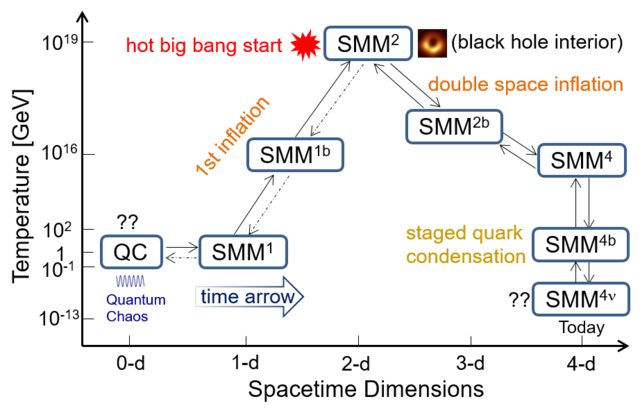[Click here for a popular summary on the new mirror matter theory]
Based on the newly proposed phenomenological mirror matter model [1-6], self-consistent extensions to the Standard Model are studied in supersymmetric mirror models [6-8] that could potentially explain the arrow of time and the big bang dynamics. The new theoretical framework also understands gravity as an emergent classical phenomenon from inflated smooth spacetime and the nature of black holes as truly 2-d objects [9,12]. The universe is dynamic and so are the underlying physical models and spacetime via topological transitions. Consistent yet different models emerge one by one with different sets of particles and interactions as spacetime evolves dynamically dimension by dimension during the big bang. A new set of first principles are proposed for building such models with new understanding of supersymmetry, mirror symmetry, and dimensional evolution of spacetime [11].
Most remarkably, the new framework has laid the foundations, in particular, providing a new mechanism of neutral hadron oscillations, for consistent and quantitative understanding of many of the most celebrated puzzles in physics: dark matter and neutron lifetime anomaly [1], evolution of stars [2], matter-antimatter imbalance [3], ultrahigh energy cosmic rays [4], unitarity of CKM [5], nature of neutrinos and dark energy [6], besides the aforementioned conundrums. In particular, a consistent picture for the origin of both baryon asymmetry and dark matter in the early Universe is presented using kaon and neutron oscillations with new insights for the electroweak and QCD phase transitions and B-violation topological processes [3]. Most importantly, various feasible laboratory experiments are proposed to test concrete unique predictions of the new theory [5], including measurement of neutron lifetime anomalies in narrow magnetic traps or under super-strong magnetic fields [5], and detection of unexpectedly large branching fractions of invisible decays of long-lived neutral hadrons [10]. All these tests, to stress again, are ready to be conducted in laboratory with the current technology.
[1] https://arxiv.org/abs/1902.01837 , published in Phys. Lett. B 797, 134921 (2019)
[2] https://arxiv.org/abs/1902.03685
[3] https://arxiv.org/abs/1904.03835 , published in Phys. Rev. D 100, 063537 (2019)
[4] https://arxiv.org/abs/1903.07474
[5] https://arxiv.org/abs/1906.10262
[6] https://arxiv.org/abs/1908.11838
[7] https://doi.org/10.31219/osf.io/8qawc
[8] https://arxiv.org/abs/2003.04687
[9] https://doi.org/10.31219/osf.io/2jywx
[10] https://arxiv.org/abs/2006.10746
[11] https://doi.org/10.31219/osf.io/cj94u
[12] https://doi.org/10.31219/osf.io/5x3kh
See https://www.wanpengtan.com/smm/ for updated versions of these articles.
See the schematic diagrams below for the evolution of the early universe under supersymmetric mirror models:


No comments:
Post a Comment